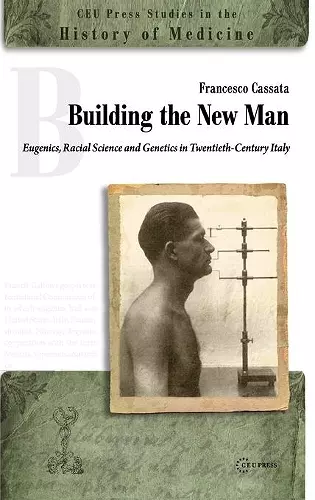Building the New Man
Eugenics, Racial Science and Genetics in Twentieth-Century Italy
Format:Hardback
Publisher:Central European University Press
Published:15th May '11
Currently unavailable, and unfortunately no date known when it will be back

Based on previously unexplored archival documentation, this book offers the first general overview of the history of Italian eugenics, not limited to the decades of Fascist regime, but instead ranging from the beginning of the 1900s to the first half of the 1970s. Discusses several fundamental themes of the comparative history of eugenics: the importance of the Latin eugenic model; the relationship between eugenics and fascism; the influence of Catholicism on the eugenic discourse and the complex links between genetics and eugenics. It examines the Liberal pre-fascist period and the post-WW2 transition from fascist and racial eugenics to medical and human genetics. As far as fascist eugenics is concerned, the book provides a refreshing analysis, considering Italian eugenics as the most important case-study in order to define Latin eugenics as an alternative model to its Anglo-American, German and Scandinavian counterparts. Analyses in detail the nature-nurture debate during the State racist campaign in fascist Italy (1938–1943) as a boundary tool in the contraposition between the different institutional, political and ideological currents of fascist racism.
"Cassata’s monograph is a long overdue and very welcome addition to the literature. It is an amalgamation of work that he has published in Italian—on Corrado Gini and related topics—and, significantly, an expansion of his Molti, sani e forti: L’eugenetica in Italia (Turin, 2006). Building the New Man is a serious and important study of an aspect of modern Italian history that remains relatively underresearched. New regional, national, and transnational case studies of eugenics in recent years have counterbalanced the Anglo-American and Nazi-centric bias in the historiography. Cassata’s book contributes exceedingly well to this ongoing and worthy project on global eugenics. The great strength of this work lies in the depth of its scholarship. Based on extensive archival research, his narrative shows great sensitivity to the plurality of approaches within Italian eugenics. Italian eugenics found a home not just in biomedicine, as was commonly the case, but also in the social sciences. The author rightly emphasizes that, despite this diversity, there was an overwhelming consensus of opinion within Italian medicine, science, and the state about the positive role that the environment, welfare, and society could play in engineering racial improvements over time. While accounts of eugenics more commonly stop in 1945, Cassata extends his chronological reach well into the 1960s. The wisdom of this choice is amply rewarded by that fact that he is thereby able to make a major contribution to one of the more interesting avenues of current scholarship on eugenics: that which is concerned to illuminate the relationship between the old and the new. Cassata examines the crucial issue of continuity in scientific and political discourses about race, and as he ably shows, the eugenetic project did not end with the fall of Fascism. No longer benefiting from Fascist state patronage, postwar Italian eugenics fell victim to discord and lost its relevance and purpose." * Journal of Modern History *
"The book's subtitle promises coverage of the twentieth century, though Cassata rewards the reader with treatment of the movement in the late nineteenth century. He does well to demonstrate the multidisciplinary character of eugenics, from its early days in Italy onward. Eugenics drew on the study of demography, biology, anthropology, law, statistics, economy, sociology and medicine. Central European University Press lists Building the New Man in its series on the history of medicine, though Cassata demonstrates that Italian eugenics owed its intellectual heritage to more than medicine. Cassata demonstrates that fascists were driven less by negative eugenics than one might have thought. Perhaps from Germany, Italy absorbed the use of sterilization sterilization, abortion and euthanasia to minimize the number of so-called degenerates. But not all fascists embraced these ideas. After World War II conflict arose between eugenicists who were racists and those who opposed racism. Tensions also arose between old-line eugenicists who favoured sterilization and abortion and Catholic eugenicists who favoured reproductive rights. Only after World War II did Italian eugenicists begin to co-opt the ideas of genetics to legitimize the movement, adding further credence to the insight that Italy was a latecomer to genetics." * Canadian Journal of History *
ISBN: 9789639776838
Dimensions: unknown
Weight: unknown
438 pages